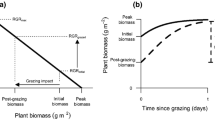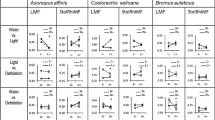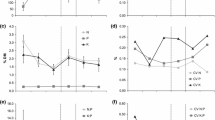Summary
We report the results of a pot experiment that examined the effects of three ecologically important factors controlling plant growth rates in savanna grasslands: defoliation, soil nitrogen and soil water availability. The experiment was conducted in the Amboseli region in east Africa, and was designed to simulate natural conditions as far as possible, using local soils and a grass species that is heavily grazed by abundant large herbivores. Productivity by different plant components was reduced, stimulated or unchanged by defoliation, depending on specific watering and fertilization treatments. Total above-ground production was stimulated by defoliation and was maximized at moderate clipping intensities, but this was statistically significant only when plants were watered infrequently (every 8 days), and most important, periods between clipping events were extended (at least 24 days). Under these conditions, plant growth rates were limited by water availability at the time of clipping, and soil water conserved in clipped, compared to unclipped plants. Within a given fertilization treatment, whole-plant production was never stimulated by defoliation because root growth was unaffected or inhibited by clipping. However, when fertilization was coupled to defoliation, as they are in the field, whole-plant production by fertilized and moderately clipped plants exceeded production by infertilized, unclipped plants. Under this interpretation, maximum whole-plant production coincided with optimum conditions for herbivores (maximum nitrogen concentration in grass leaves) when watering was frequent, and plants were moderately defoliated. However, these conditions were not the same as those that maximized relative above-ground stimulation of growth (infrequent watering and clipping).
The results indicate that above-ground grass production can be stimulated by grazing, and when that is likely to occur. However, the results emphasize that plant production responses to defoliation can vary widely, contigent upon a complex interaction of ecological factors.
Similar content being viewed by others
References
Andere DK (1981) Wildebeest Connochaetes taurinus (Burchell) and its food supply in Amboseli Basin. Afr J Ecol 19:239–250
Belsky AJ (1986) Does herbivory benefit plants? A review of the evidence. Am Nat 127:870–892
Belsky AJ (1987) The effects of grazing: confounding of ecosystem, community and organism scales. Am Nat 129:777–783
Chapin FS III, McNaughton SJ (1989) Lack of conpensatory growth under phosphorus deficiency in grazing-adapted grasses from the Serengeti Plains. Oecologia (in press)
Hilbert DW, Swift DM, Detling JK, Dyer MI (1981) Relative growth rates and the grazing optimization hypothesis. Oecologia 51:14–18
Jeffries RL (1988) Vegetational mosaics, plant-animal interactions and resources for plant growth. In: Gottlieb LD, Jain SK (eds) Plant evolutionary biology. Chapman and Hall, London, pp 341–369
McNaughton SJ (1976) Serengeti migratory wildebeest: facilitation of energy flow by grazing. Science 191:92–94
McNaughton SJ (1979a) Grazing as an optimization process: grass-ungulate relationships in the Serengeti. Am Nat 113:691–703
McNaughton SJ (1979b) Grassland-herbivore dynamics. In: Sinclair ARE, Norton-Griffiths M (eds) Serengeti: dynamics of an ecosystem. University of Chicago Press, Chicago, pp 82–103
McNaughton SJ (1983a) Compensatory plant growth as a response to herbivory. Oikos 40:329–336
McNaughton SJ (1983b) Serengeti grassland ecology: the role of composite environmental factors and contingency in community organization. Ecol Monogr 53:291–320
McNaughton SJ (1985) Ecology of a grazing ecosystem: the Serengeti. Ecol Monogr 55:259–294
McNaughton SJ (1986) On plants and herbivores. Am Nat 128:765–770
McNaughton SJ, Chapin FS III (1985) Effects of phosphorus nutrition and defoliation on C4 graminoids from the Serengeti Plains. Ecology 66:1617–1629
Osterheld M, McNaughton SJ (1988) Intraspecific variation in the response of Themeda triandra to defoliation: the effect of the time of recovery and growth rates on compensatory growth. Oecologia 77:550–556
Ruess RW (1989) The interaction of defoliation and nutrient uptake in Sporobolus kentrophyllus, a short-grass species from the Serengeti plains. Oecologia 77:181–186
Ruess RW, McNaughton SJ, Coughenour MB (1983) The effects of clipping and fertilization on nitrogen nutrition and allocation by mycorrhizal and nonmycorrhizal Panicum coloratum L., a C4 grass. Oecologia 54:68–71
Western D (1973) The structure, dynamics and changes of the Amboseli Ecosystem. PhD. Thesis, University of Nairobi
Author information
Authors and Affiliations
Rights and permissions
About this article
Cite this article
Georgiadis, N.J., Ruess, R.W., McNaughton, S.J. et al. Ecological conditions that determine when grazing stimulates grass production. Oecologia 81, 316–322 (1989). https://doi.org/10.1007/BF00377077
Received:
Accepted:
Issue Date:
DOI: https://doi.org/10.1007/BF00377077




